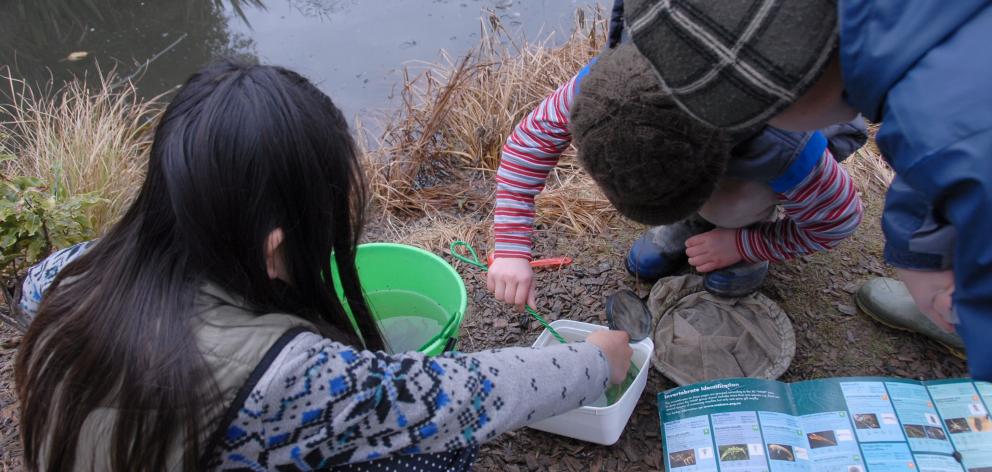
The unfettered spirit of pupils revelling in the wonders of the woods — daytime visitors at Orokonui Ecosanctuary can almost smell their infectious young energy.
But few witness the change at sunset: darkness descends upon the valley and unseen nocturnal creatures emerge in the moonlight. The air now almost buzzes with electric anticipation for what is to come.
That is one of the many ways a sleepover differs greatly from a regular excursion at Orokonui. Following the burgeoning popularity of night tours, ecosanctuary staff amped up the experience with Nature by Night, a sleepover programme.
Children could now experience the forest bush by night in a safe environment, coupled with the dizzy excitement only a sleepover could bring. School groups, scout camps, and specialised programmes have since opted for sleepovers, and the experience is nothing short of magical.
On the afternoon of a sleepover, Orokonui’s educators welcome a group into the ecosanctuary and treat them to walks around the kaka and tui loop tracks. The scene before them is familiar — sunlight filtering through the canopy, korimako/bellbirds whistling at the feeders, the heady honey-mist of tarata/lemonwood flowers hanging in the air. With these images imprinted in their minds, the group heads back to base for a sizzling barbecue dinner, where their hosts prepare them for the most important part of their day — the night.

The most important message before night tours emphasises the sensitivity of native nocturnal animals. Orokonui is home to Haast tokoeka/Haast brown kiwi, a rare and vulnerable species susceptible to loud noises and bright lights. To spot a kiwi safely, the children are told they need to stay quiet, tread lightly, and use only red lights to search for and see the bird. This protocol goes for most nocturnal creatures. To survive the night, one must become the night! The children receive this message with a solemn spirit. They are determined to respect the forest and its inhabitants. At dusk, with boots laced and warm jackets zipped up, the group heads through the predator-exclusion fence and into the dark.
A cacophony of sounds fills the night, ranging from crickets chirping, starlings wailing, and ruru (or morepork) hooting in surround sound. The tiniest rustle stops the group in their tracks, making them hold their breath to see what emerges. Their patience is occasionally rewarded. Pupils from Tokomairiro High School (on a sleepover trip last August) watched a male kiwi trundle up the track to greet a female with shrill, repetitive calls. A brief stop to spotlight at the pond reveals the resident eel Waimarie, sleepy and confused. While the bush seems magical in such moments, it can also be overwhelming in equal measure. On the last leg of their night walk, a group of Grant Braes Brownies felt the cold swoosh of a native bat brushing their cheeks. They huddled tremulously and some wondered if vampire bats existed. Their guide was able to allay their fears, allowing them to finish their tour.

The night tours are not the end of it.
After supper, on clear nights, pupils gaze at the stars, trying to find the distinct cluster of Matariki and the stars forming Orion. Sometimes pupils are treated to Maori stories about the stars, of how the arrival of Puaka (the Rigel star of Orion), the bringer of food, signalled the start of the year and a season of plentiful food.
On cloudier nights, groups follow silver fern trails around the visitor centre, learn about tracking tunnels and traps, and lie on the deck listening to birds and smelling sweet petrichor rising from the forest floor.
With lights-out scheduled between 9pm and 10pm, bedtime rituals are quick to commence. Sleepover groups camp inside the warm visitor centre. While preparing for bed, younger children are often handed a native bird toy (or, if they’re lucky, a big poofy peripatus) to sleep with. Often when it is time for bed they are too excited to sleep. Night-time stories follow of kiwi and moa and of strange happenings in the woods. On rougher nights, a soft lullaby on the guitar puts the tired group to sleep.
Sunrise brings the morning rush to get ready to leave. Groups that choose to complete the valley walk after their stay marvel at how drastically different the forest is by day! That is the beauty of nature by night: in seeing a familiar place in a new light, one forms a deeper connection with the native bush and gains a new perspective of how our beautiful wildlife thrives in a myriad of ways. Orokonui’s sleepover programme leaves a lasting impression — visitors check out and depart, but the sleepover memories are there to stay.
- Ash Muralidhar, formerly one of the education team at Orokonui, is now the Environmental Educator at the Rotokare fenced sanctuary in Taranaki.











